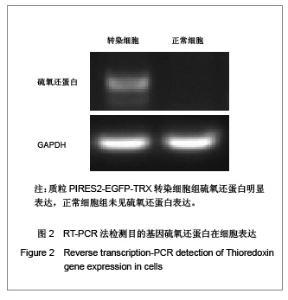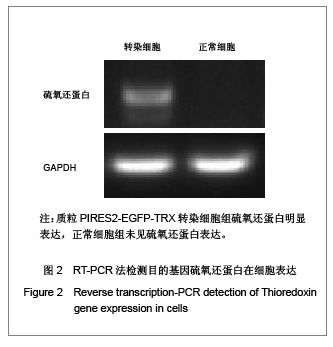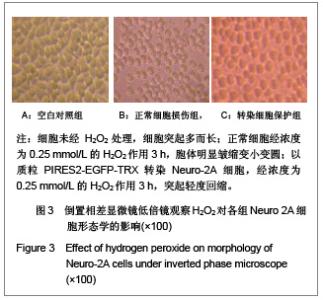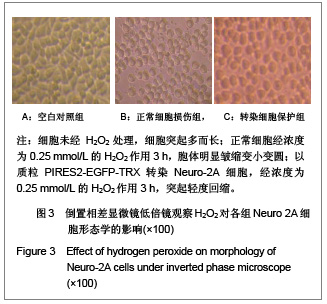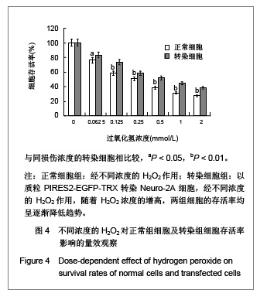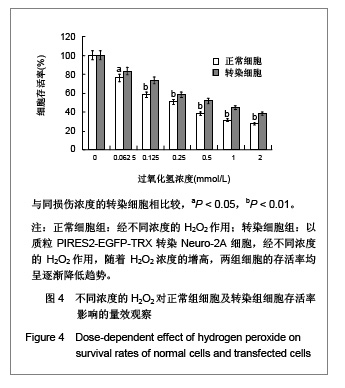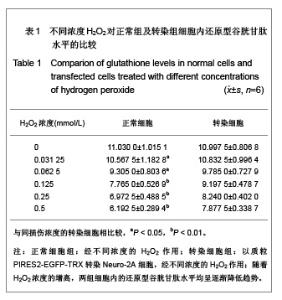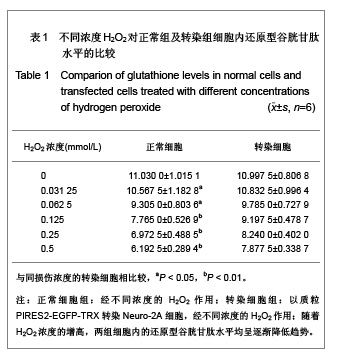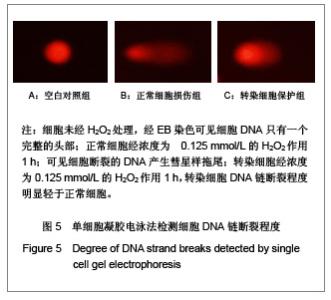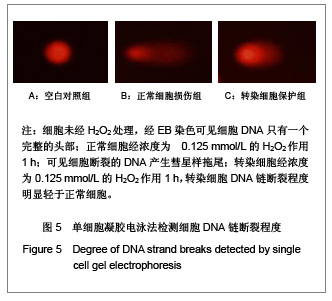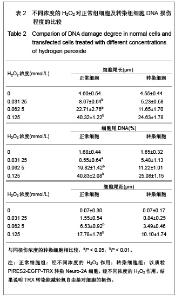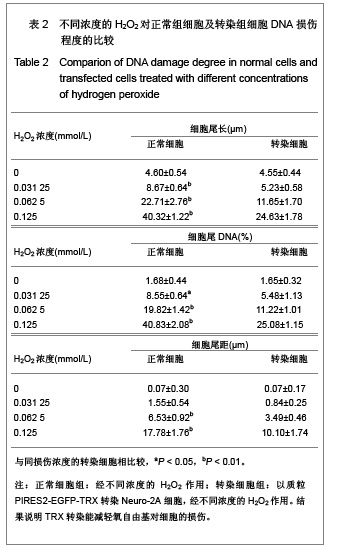Chinese Journal of Tissue Engineering Research ›› 2013, Vol. 17 ›› Issue (11): 2026-2031.doi: 10.3969/j.issn.2095-4344.2013.11.019
Previous Articles Next Articles
Thioredoxin gene recombination and expression in Neuro-2A cells
Wang Long, Lü Guo-feng
- Department of Sports Medicine, Dalian Medical University, Dalian 116000, Liaoning Province, China
-
Received:2012-08-29Revised:2012-09-10Online:2013-03-12Published:2013-03-12 -
Contact:Lü Guo-feng, Master, Professor, Master’s supervisor, Department of Sports Medicine, Dalian Medical University, Dalian 116000, Liaoning Province, China lgf5411@yahoo.com.cn -
About author:Wang Long★, Studying for master’s degree, Department of Sports Medicine, Dalian Medical University, Dalian 116000, Liaoning Province, China
CLC Number:
Cite this article
Wang Long, Lü Guo-feng. Thioredoxin gene recombination and expression in Neuro-2A cells[J]. Chinese Journal of Tissue Engineering Research, 2013, 17(11): 2026-2031.
share this article
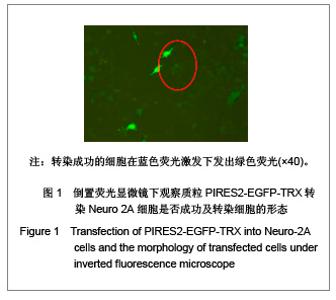
2.1 质粒PIRES2-EGFP-TRX转染Neuro 2A细胞 转染96 h内,于倒置荧光显微镜下观察细胞形态,由于质粒中携带有绿色荧光蛋白(EGFP),转染成功的细胞在蓝色荧光的激发下可以发出绿色荧光。 2.2 RT-PCR法检测目的基因硫氧还蛋白的表达 见图2,质粒PIRES2-EGFP-TRX转染细胞组硫氧还蛋白明显表达,正常细胞组未见硫氧还蛋白表达;而两组内参照GAPDH未见明显差别。 2.3 氧化模型建立后细胞形态学观察 对两种细胞分别用浓度为0.25 mmol/L的H2O2作用3 h,于倒置相差显微镜下观察:空白对照组细胞不规则呈铺路石样贴壁生长,细胞饱满呈多边形,有较强的折光性和立体感,细胞突起多而长;正常细胞损伤组细胞贴壁性差,突起回缩,胞体明显皱缩变小变圆,折光性及立体感较差;转染细胞保护组细胞,多数细胞形态正常或轻度受损,贴壁状态良好,胞体尚饱满,折光性和立体感尚可,突起轻度回缩,少数细胞皱缩变圆。"
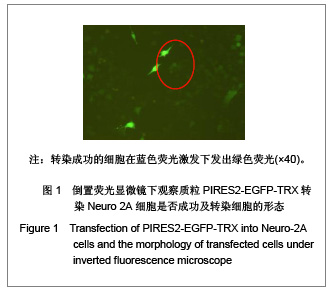
| [1] Yang Y, Song Y, Loscalzo J.Regulation of the protein disulfide proteome by mitochondria in mammalian cells.Proc Natl Acad Sci USA.2007;l04(26):10813-10817.[2] Choi EJ, Ahn WS.Neuroprotective effects of chronic hesperetin administration in mice.Arch Pharm Res.2008; 31(11): 1457-1462.[3] Kayali H, Ozdag M F, Kahraman S, et al.The antioxidant effect of beta-Glucan on oxidative stress status in experimental spinal cord injury in rats.Neurosurg Rev.2005;28(4):298-302.[4] Powis G, Montfort WR.Properties and biological activities of thioredoxins.Annu Rev Pharmacol Toxicol.2001;41:261-295.[5] Nakamura H.Thioredoxin and its related molecules:update 2005.Antioxid Redox Signal.2005;7(5-6):823-828.[6] Yamagata K, Tagam in M. Altered gene expressions during hypoxia and reoxygenation in cortiacal neuronsisolated from stroke prone spontaneously hypertensiverates. Neuro sici L ett.2002;84: 131-134.[7] Lovell MA, Xie CS, Gabbita SP, et al Decreased thioredoxinan increased thioredoxin reduction levels in Alzheimers disease disease brain. Free Radic Bio Med.2000;28: 418-427.[8] Benn SC.Woolf CJ.Adult neuron survival strategies slamining on the brakes.Nat Rev Neurosci.2004;5:686-700.[9] Park DS, Morris EJ, Stefanis L, et al.Multiple pathways of neuronal death induced by DNA—damaging agents, NGF deprivation, and oxidative stress.J Neurosci.1998;18(3): 830-840.[10] Kim YC, Masutani H, Yamaguchi Y, et al. Hemin - induced Activation of the Thioredoxin Gene by Nrf2. J Biol Chem.2001; 276(21) :18399 - 18406.[11] Kanzok SM, Fechner A, Bauer H, et al. Substitution of the Thioredoxin System for Glutathione Reductase in Drosophila melanogaster. Sience.2001; 291(26):643-645.[12] Hissin PJ,Hilf R. A fluorometric method for determination of oxidized and reduced glutathione in tissues.Anal. Biochem. 1976;74(1):214-226.[13] Singh NP, Stephens RE. Microgel electrophoresis:sensitivity, mechanisms,and DNA electrostretching,Mutat.Res.1997;383(3):167-175.[14] Zhang KF, Zhang ZP, Chen Y, et al. Dongwu Zazhi.2007; 42(2): 153-160. 张克烽,张子平,陈芸,等,动物抗氧化系统中主要抗氧化酶基因的研究进展[J].动物学杂志, 2007, 42(2):153-160.[15] Olanow CW.Oxidation reactions in Parkinson’s disease. Neurology 1990;40(10 suppl 3): suppl 32-7;discussion 37-9.[16] Zhang XT, Xiong YM. Guowai yixue: yixue Dili Fence.2004; 25(4):148-158. 张笑天,熊咏民.硫氧还蛋白还原酶研究进展[J].国外医学:医学地理分册, 2004, 25(4):148-158.[17] Patenaude A, Murthy M R, Mirauh M E.Emerging roles of thioredoxin cycle enzymes in the central nervous system.Cell Mol Life Sci.2005,62(1O):1063-1080.[18] Takagi Y, Mitcui A, Nishiyama A, et al.Overexpression of thioredoxin in transgenic mice attenuates focal ischemic brain damage.Proc Natl Acad Sci USA.1999;96(7):4131-4136.[19] Madri JA , Graesser D.Cell migration in the immue system:the evolve –inginter-related roles of adhesion molecules and proteinases.Dev Immunol.2000;7:103-ll6.[20] Spector A, Yan GZ, Huang RR,et al. The effect of H2O2 upon thioredoxin-enriched lens epithelial cells. J Biol Chem. 1988; 263(10):4984-4990.[21] Nappi AJ,Vass E.Comparative studies of enhanced iron-mediated production of hydroxyl radical by glutathione,cysteine,ascorbic acid,And selected catechols. Biochim Biophys Acta.1997;1336(2):295-302.[22] Kanzok SM, Fechner A, Bauer H, et al. Substitution of the Thioredoxin System for Glutathione Reductase in Drosophila melanogaster. Sience.2001;291(26):643-645.[23] Fairbairn DW,Olive PL,O’Neill KL.The comet assay:a comprehensive review.Mutat.Res.1995;339(1):37-59. |
| [1] | Pu Rui, Chen Ziyang, Yuan Lingyan. Characteristics and effects of exosomes from different cell sources in cardioprotection [J]. Chinese Journal of Tissue Engineering Research, 2021, 25(在线): 1-. |
| [2] | Pei Lili, Sun Guicai, Wang Di. Salvianolic acid B inhibits oxidative damage of bone marrow mesenchymal stem cells and promotes differentiation into cardiomyocytes [J]. Chinese Journal of Tissue Engineering Research, 2021, 25(7): 1032-1036. |
| [3] | Luo Anyu, Liu Hanlin, Xie Xiaofei, Huang Chen. Effect of antioxidant mixture on structural degeneration of an osteoarthritis rat model [J]. Chinese Journal of Tissue Engineering Research, 2021, 25(23): 3625-3629. |
| [4] | Wang Jing, Wu Jiangbo. Irisin mediates protective effects on failing heart via integrin alpha V receptors [J]. Chinese Journal of Tissue Engineering Research, 2021, 25(20): 3219-3225. |
| [5] | Cong Renyuan, Yuan Jing, Xia Jinchan, Sun Ying . Effects of baicalin on oxidative stress in BEAS-2B cells stimulated by lipopolysaccharide combined with adenosine triphosphate [J]. Chinese Journal of Tissue Engineering Research, 2021, 25(2): 286-291. |
| [6] | Dai Yaling, Chen Lewen, He Xiaojun, Lin Huawei, Jia Weiwei, Chen Lidian, Tao Jing, Liu Weilin. Construction of miR-146b overexpression lentiviral vector and the effect on the proliferation of hippocampal neural stem cells [J]. Chinese Journal of Tissue Engineering Research, 2021, 25(19): 3024-3030. |
| [7] | Zhang Hongqing, Xie Xufang, Wu Xiaomu. Effectiveness and clinical application limitations of stem cells in the treatment of multiple sclerosis and optic neuromyelitis spectrum diseases [J]. Chinese Journal of Tissue Engineering Research, 2021, 25(19): 3049-3056. |
| [8] | Zhou Yi, Chen Yueping, Zhang Xiaoyun, Lai Yu, Liao Jianzhao, Li Shibin. An exploration on mechanism of Shengyu Decoction in treating osteonecrosis of the femoral head based on network pharmacology [J]. Chinese Journal of Tissue Engineering Research, 2021, 25(17): 2687-2696. |
| [9] | Yuan Baohong, Zhao Weishan, Wang Ruotian, Guan Aoran, Wang Yu, Li Ruhong. Bone marrow mesenchymal stem cells from pigs inhibit inflammatory response induced by lipopolysaccharide and improve islet cell dysfunction in pigs [J]. Chinese Journal of Tissue Engineering Research, 2021, 25(13): 1969-1975. |
| [10] | Zhao Ning, Yu Hongdan, Feng Zhen, Ding Jiayuan, Liu Xuezheng. Salidroside inhibits apoptosis of retinal Müller cells induced by high glucose in rats [J]. Chinese Journal of Tissue Engineering Research, 2021, 25(11): 1664-1669. |
| [11] | Xu Guofeng, Li Xuebin, Tang Yifan, Zhao Yin, Zhou Shengyuan, Chen Xiongsheng, Jia Lianshun. The role of autophagy in ossification of the human ligamentum flavum [J]. Chinese Journal of Tissue Engineering Research, 2020, 24(8): 1174-1181. |
| [12] | Mao Zhenli, Song Zhenquan, Zhang Haisong, Liu Enzhi. Effect of 8-hydroxy-2-(di-n-propylamino)tetralin on hypoxia inducible factor 1 alpha expression following diffuse axonal injury in rats [J]. Chinese Journal of Tissue Engineering Research, 2020, 24(8): 1238-1242. |
| [13] | Wan Huazhe, Chai Guangxin, Xiao Xiaoling, Huang Wenying. Effects of phellinus igniarius crude polysaccharides on sporting ability and free radical metabolism of skeletal muscle in mice suffering passive smoking [J]. Chinese Journal of Tissue Engineering Research, 2020, 24(5): 689-693. |
| [14] | Yu Hui, Zhao Yang, Fei Jiayue, Zhang Wenli, Zhao Luosha. Isoliquiritigenin inhibits SETD7 expression against oxidative damage in cardiomyocytes induced by hypoxia/reoxygenation [J]. Chinese Journal of Tissue Engineering Research, 2020, 24(35): 5613-5618. |
| [15] | Cerebral Protection in Cardiac Intensive Care Group, Neural Regeneration and Repair Committee, Chinese Research Hospital Association, Neural Intensive Nursing and Rehabilitation Group, Neural Regeneration and Repair Committee, Chinese Research Hospital Association. Chinese expert consensus on the diagnosis and treatment of postoperative brain injury in adult cardiac surgery [J]. Chinese Journal of Tissue Engineering Research, 2020, 24(32): 5203-5212. |
| Viewed | ||||||
|
Full text |
|
|||||
|
Abstract |
|
|||||
